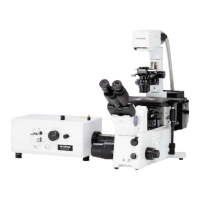APPLIED OPERATIONS/Image Acquisition
IV.
OPERATION INSTRUCTIONS
IV .
2-56
Page
2-2-3 Differences in Image Acquisition Method Between Fluorescent and
Transmitted Images
2-2-3-1 Monochrome Image
The wavelength obtained by monochrome dyeing can be acquired and observed as an
image of a channel (either Ch1 or Ch2).
The subsequent description deals with the differences in operation between the
monochrome dyeing and dual-fluorochrome dyeing.
When the specimen is dyed so that the wavelength of the fluorescence emission from it
is below 570 nm, the image is acquired in channel 1 (Ch1).
When the specimen is dyed so that the wavelength of fluorescence emission from it is
above 570 nm, the image is acquired in channel 2 (Ch2).
z Set the [DETECTION MODE] lever of the scan unit to “FL -” or “- FL”.
FL -: When acquiring the image in Ch1.
- FL: When acquiring the image in Ch2.
z Engage the filter by setting the [BARRIER FILTERS] lever of the scan unit. (Setting
the lever to “IN” engages the filter.)
CH1: When observing a specimen dyed to generate fluorescence wavelength
below 570 nm.
CH2: When observing a specimen dyed to generate fluorescence wavelength
above 570 nm.
Also see section 2-2-1-2, “Configuring the Scan Unit“ and follow the instructions given
by the [Microscope Configuration] window.

